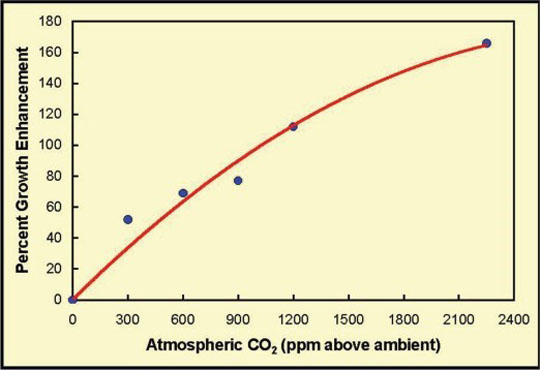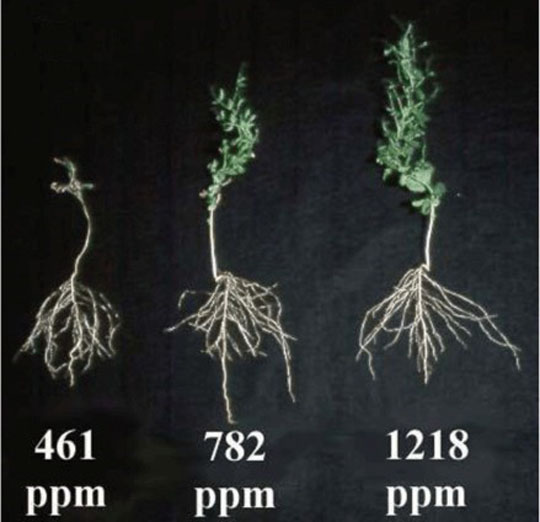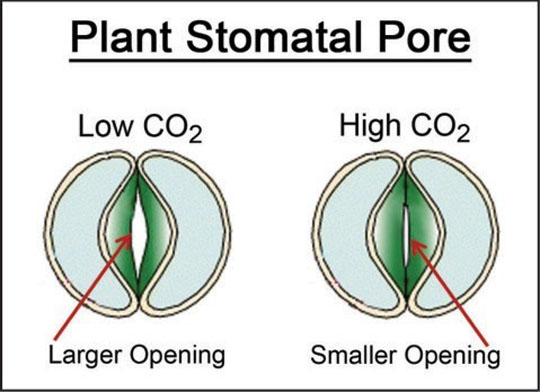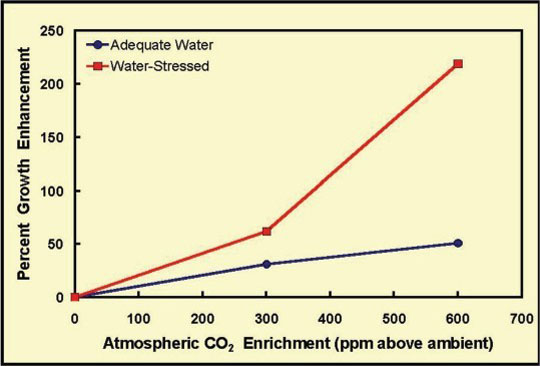by Craig Idso
We on Earth benefit from the rise of atmospheric CO2. But we seldom hear this important fact and its critical implications. Studying the biological impacts of rising atmospheric CO2 has occupied my professional life for nearly three decades now. Time and again, governments, non- governmental organizations, international agencies, societal think tanks, and even respectable scientific organizations undertake to spend multiple millions of dollars writing and promoting large reports about climate change. Yet in nearly all of these endeavors they have failed by not properly evaluating, or even acknowledging, the manifold real and measurable benefits of the ongoing rise in the air’s CO2 content. As a result, the positive impacts of atmospheric CO2 enrichment remain largely ignored.
There are three main benefits of atmospheric CO2 enrichment: more CO2 increases plant productivity, enhances plant water use efficiency, and helps plants to withstand and better endure various environmental and resource limitations and stresses.
Regarding plant productivity, carbon dioxide is the primary raw material utilized by plants during the process of photosynthesis to build and construct their tissues. It is the “food” that sustains essentially all plants on the face of the Earth. And the more CO2 they “eat” or take in from the air, the bigger and better they grow, a fact that has been conclusively demonstrated in thousands of laboratory and field experiments.
This following figure illustrates this truly amazing benefit. As the atmosphere’s CO2 concentration increases to six times above that of its current value, this extra “food,” if you will, induces a growth enhancement in most plants that reaches upwards of 160 percent.

Adding CO2 to the atmosphere enhances plant growth. Source: adapted from Idso, K.E. 1992. Plant responses to rising levels of atmospheric carbon dioxide: a compilation and analysis of the results of a decade of international research into the direct biological effects of atmospheric CO2 enrichment. Climatological Publications Scientific Paper No. 23, Office of Climatology, Arizona State University, Tempe, Ariz.
In next figure, we see the growth-enhancing effects of atmospheric CO2 enrichment on pea plants. All plants in the figure were grown under identical conditions except atmospheric CO2 content. Grown under three different atmospheric CO2 concentrations, the effects of CO2 fertilization are readily apparent in the leaf, stem, and root biomass. The plant on the left is clearly deficient on all counts.

The only difference in growing conditions for these plants is the parts per million of atmospheric CO2 as noted beneath each specimen.
My employer, the Center for the Study of Carbon Dioxide and Global Change, has studied the effects of atmospheric CO2 on plants for decades. On its website, http://www.co2science.org is a Plant Growth database, where the results of thousands of laboratory and field CO2 enrichment studies are archived.
Based on the numerous experiments listed there, we have determined that a 300 parts per million (ppm) increase in the air’s CO2 content will typically raise the productivity of most herbaceous plants by about one third. This stimulation is generally manifested by an increase in the number of branches and tillers, more and thicker leaves, more extensive root systems, plus more flowers and fruit.
A study I conducted several years ago found that a 300 ppm increase in atmospheric CO2 enrichment leads to yield increases of 15 percent for CAM crops, 49 percent for C3 cereals, 20 percent for C4 cereals, 24 percent for fruits and melons, 44 percent for legumes, 48 percent for roots and tubers, and 37 percent for vegetables, on average.
Although much less studied than terrestrial plants, many aquatic plants are also known to be responsive to atmospheric CO2 enrichment, including unicellular phytoplankton and bottom-rooted macrophytes of both freshwater and saltwater species. Hence, there is probably no category of photosynthesizing plant that does not respond positively to atmospheric CO2 enrichment and that is not likely to benefit from the ongoing rise in the air’s CO2 content.
It should come as no surprise, therefore, that the father of modern research in this area—Dr. Sylvan H. Wittwer—has stated that “it should be considered good fortune that we are living in a world of gradually increasing levels of atmospheric CO2,” and that “the rising level of atmospheric CO2 is a universally free premium, gaining in magnitude with time, on which we can all reckon for the future.”
So what does the growth-enhancing benefit of atmospheric CO2 enrichment portend for the biosphere? One obvious consequence is greater crop productivity. Many researchers have acknowledged the yield-enhancing benefits of the historical and still-ongoing rise in the air’s CO2 content on past, present, and future crop yields, yet scientists are only scratching the surface of the potential benefits such yield enhancements can bring.
Consider rice, at 9.4 percent of global food production. Based upon data presented in our CO2 Science Plant Growth Database, the average growth response of rice to a 300 ppm increase in the air’s CO2 concentration is positive 37.5 percent. However, data obtained from De Costa et al. (2007), who studied the growth responses of sixteen different rice genotypes, revealed CO2-induced productivity increases ranging all the way from negative 7 percent to positive 263 percent. Therefore, if farmers identified which genotypes provided the largest yield increases per unit of CO2 rise, and then grew those genotypes, global food supply would continue to expand rapidly.
The second major benefit of atmospheric CO2 enrichment is increased plant water use efficiency—the amount of biomass produced by a plant per unit of water lost via transpiration. The next figure represents two typical stomatal pore configurations. Plants exposed to elevated levels of atmospheric CO2 generally do not open their leaf stomatal pores as wide as they do at lower CO2 concentrations. The result is a reduction in most plants’ rates of water loss by transpiration. The amount of carbon they gain per unit of water lost therefore typically rises for a doubling of CO2 on the order of 70 to 100 percent.

The wide-open Low CO2 stomatal pore allows more H2O to escape from the plant compared to the High CO2 pore, if other factors are held constant. This causes more water-loss plant stress in arid regions.
Thus, at higher atmospheric CO2 concentrations it has been ob served that plants need less water to produce the same—or an even greater—amount of biomass.
With smaller stomatal openings, plants exposed to elevated levels of atmospheric CO2 are generally less susceptible to drought. As such, they will be able to grow and reproduce where it has previously been too dry for them to exist. Consequently, Earth’s terrestrial vegetation should become more robust as the air’s CO2 concentration rises, and should begin to win back lands previously lost to desertification. Simultaneously, the greater vegetative cover of the land produced by this phenomenon should reduce the adverse effects of wind and rain soil erosion.
With respect to the third major benefit of atmospheric CO2 enrichment—the amelioration of environmental stresses and resource limitations—atmospheric CO2 has been shown to help reduce the detrimental effects of high soil salinity, high air temperature, low light intensity, and low levels of soil fertility. Elevated levels of CO2 also reduce the severity stresses of low temperature, of oxidation, and of herbivory. What is more, the percentage growth enhancement produced by an increase in the air’s CO2 content is often greater under stressful and resource-limited conditions than under optimal growing conditions.
Returning to water resources to illustrate this third benefit, the percent growth enhancement due to atmospheric CO2 enrichment increases when water availability is less than ideal, as shown in the following figure.

Higher levels of atmospheric CO2 support greater plant growth in dry conditions. This is a cause of the global greening of arid regions as documented by space photographs.
For example, a plant growing in adequate water conditions will experience about a 35 percent increase in productivity for a 300 ppm increase in CO2. But that same plant growing in a water-stressed environment would experience a much greater 65 percent increase in productivity for a 300 ppm increase in CO2. That benefit becomes even larger as the CO2 concentration rises.
Further, research shows that a doubling of the air’s CO2 concentration typically boosts the optimum temperature for plant photosynthesis by several degrees centigrade, and it raises the temperature at which plants experience heat-induced death by about the same amount.
Therefore, most types of vegetation, with the help of the extra CO2, will likely be able to tolerate much warmer living conditions than they do currently, even if temperatures were to rise as high as is unrealistically predicted by the most pessimistic climate models.
Based on a multitude of real-world observations, the future is now. Evidence from all across the globe indicates that the terrestrial biosphere is already experiencing a great planetary greening, likely in large measure due to the approximate 40 percent increase in atmospheric CO2 since the beginning of the Industrial Revolution.
Perhaps most surprising about these observations is the fact that this great greening of the Earth has occurred despite many assaults of both man and nature on Earth’s vegetation over this time period, including fires, disease, pest outbreaks, deforestation, war, and climatic changes in temperature and precipitation.
In considering each of the CO2 enrichment benefits discussed above, instead of being shunned like the plague, the ongoing rise in atmospheric CO2 should be welcomed with open arms. Carbon dioxide is not a pollutant— it is the very elixir of life.
Reprinted with permission and included in The Climate Surprise (http://co2coalition.org/2016/07/29/the-climate-surprise-why-co2-is-good-for-the-earth/)

